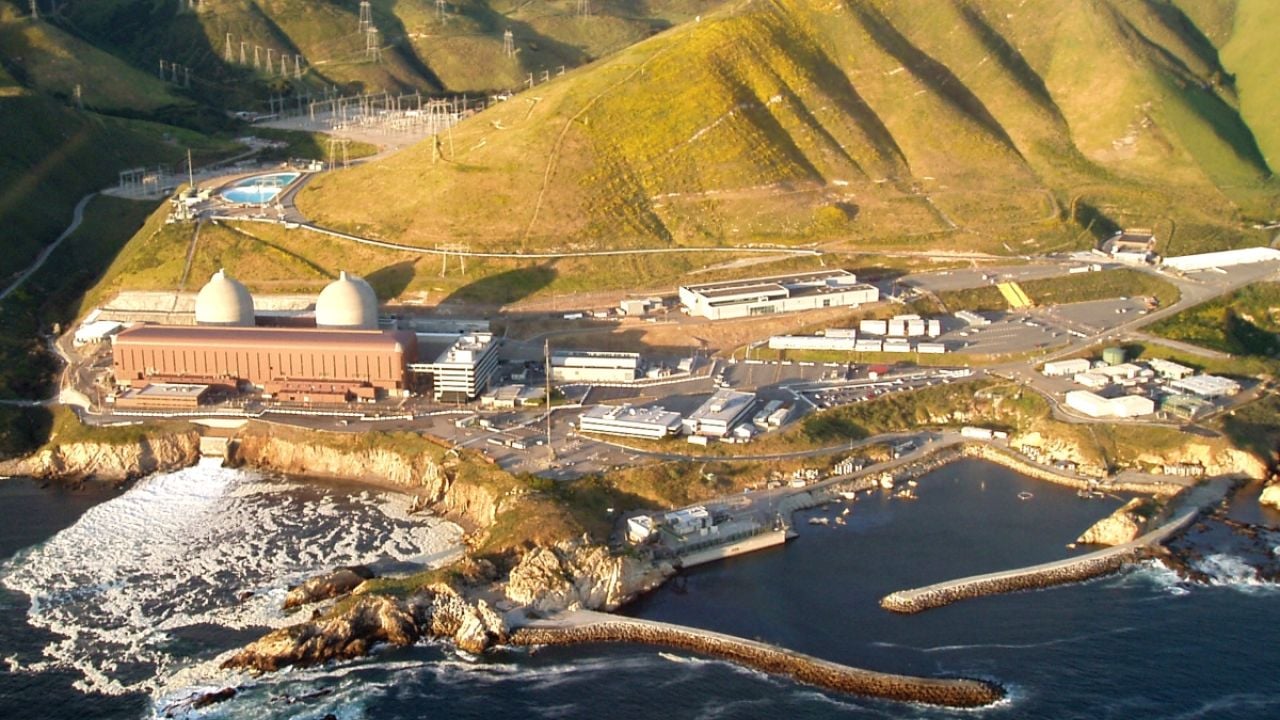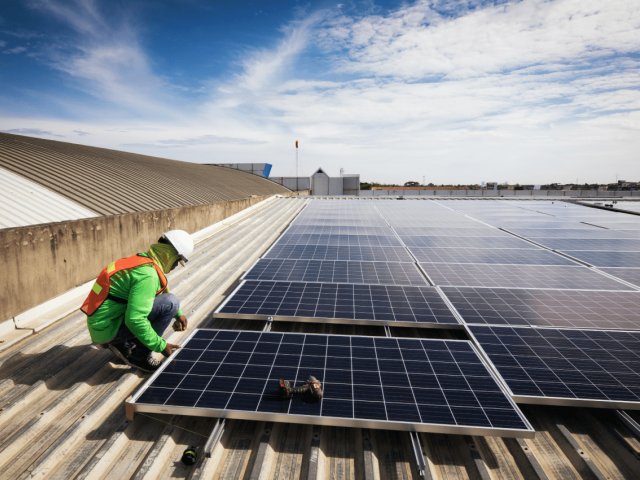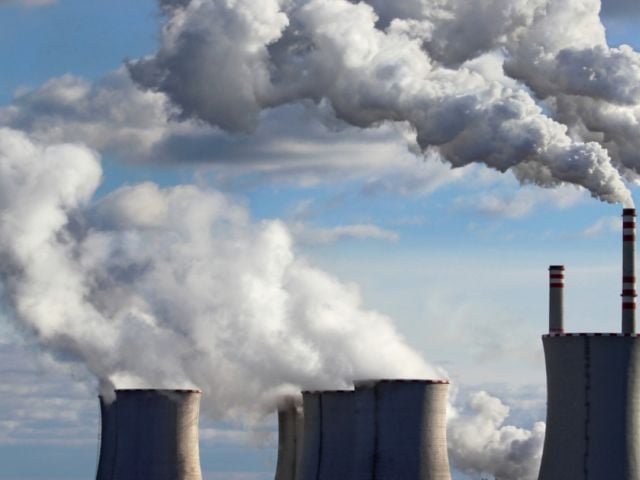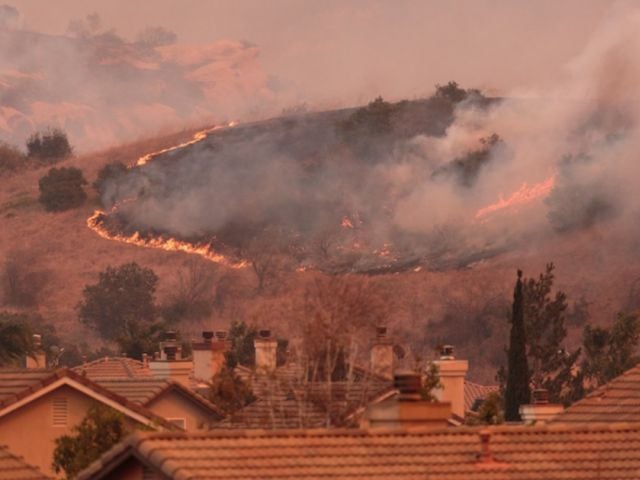
Overview
- Keeping the decrepit Diablo Canyon plant open till 2045 is costly and dangerous.
- New EWG analysis finds annual costs could be hundreds of millions.
- Flaws found in study are being used to justify keeping the facility open.
If something costs tens of billions to keep, without any clear financial benefits to ratepayers but with the risk of nuclear catastrophe, prolonging it would be folly. But that’s what supporters of California’s aging Diablo Canyon nuclear power plant are pursuing by fighting to keep it open.
The plant had been scheduled to close its two nuclear reactor units by 2025, with Unit 1 set for closure in 2024 and Unit 2 to close in 2025. But a misguided push is underway to extend the life of the facility far into the future.
In a new analysis, the Environmental Working Group lays clear just how catastrophic it would be for the climate, ratepayers and public safety to prolong the life of the aging, decrepit plant, which is owned by the notoriously mistake-prone Pacific Gas & Electric power company.
EWG used testimony recently filed by the Utility Reform Network, or TURN, in PG&E’s current rate case to parse the capital and operating expenses of the plant. EWG considered PG&E’s estimates for the plant costs, which likely lowball the true expense, and TURN’s assessment of the plant expenses, which may be closer to the actual burden. EWG estimates it will likely amount to hundreds of millions of dollars every year, for total costs ranging from more than $20 billion to nearly $45 billion from 2023 through 2045 – or more. Even assuming PG&E’s cost estimates, Californians will be on the hook for over $20 billion, but likely much more. That’s just the base cost of running the facility. The alarming figure doesn’t account for the additional massive costs that would come from a disaster at the plant, like an earthquake or a nuclear reactor leak, or unanticipated maintenance and security costs, which often plague old nuclear power plants.
That cost will be passed on to 15.8 million Californians already fleeced by PG&E’s exorbitant electricity bills. By EWG’s estimates, keeping Diablo Canyon open could add from $55 to $124 a year to the typical utility bill, considering the cost of the facility as a fixed charge over 23 years. Or it could be even higher because these costs, at the moment, are highly speculative and because the older Diablo Canyon gets, the higher the capital and operating costs will become to keep it online and providing electricity.
It’s clearly a high-cost, no-reward and puzzling scenario for California, given its decades-long leadership on the environment, including strict regulations to help the transition from dirty fossil fuels to forward-thinking measures, like renewables and battery storage, that fight the climate crisis.
In addition, the costs of Diablo Canyon to ratepayers are additive – that is, in addition to the planned renewable, energy storage and energy efficiency investments the state plans to make. There are no savings for ratepayers, only additional billions in costs.
Why the 2045 timeframe?
By California law – Senate Bill 846, passed in 2022 – the plant is slated to remain online until 2030. Despite state law, PG&E says it will pursue a 20-year extension of its operating license in the application that it must file with the Nuclear Regulatory Commission, or NRC, by December 31. Otherwise, the plant would have been shuttered by 2025 following an agreement among advocates, unions and PG&E that was approved by state regulators in 2018. Therefore, if approved by the NRC, PG&E would be able to operate the plant until 2045.
But a license extension filed with the NRC does not have to be for 20 years. NRC regulations leave that up to the applicant. The only stipulation is that the request may not exceed 20 years. PG&E indicated they would pursue an extension for 20 years, claiming the NRC requires it. This is a ruse.
Furthermore, it is likely PG&E will argue that a longer operating timeframe will allow the company to spread the power plant’s costs over a greater period – keeping year-to-year costs lower. It would also be financially more lucrative for the company, as more investments will surely be needed to keep the plant operating.
In other words, PG&E has gotten its foot in the door and can continue to leverage fears of blackouts and propagate the usual nuclear industry spin of safe, clean, cost-effective power, none of which is true. Most importantly, this effort will crowd out cheaper and cleaner alternatives like solar, wind, energy storge, demand response and efficiency, which are the best near- and mid-term investment options to address climate change and maintain electric system reliability.
Diablo Canyon’s hellish history
Operating since 1985, Diablo Canyon has two nuclear reactors, known as Units 1 and 2, that produce what PG&E reports is 18,000 gigawatt-hours of “clean and reliable energy” annually.
But the renewable power revolution that gained momentum in 2009 in California and across the U.S. led to calls for switching from potentially unsafe nuclear power to embracing solar, wind, geothermal, battery storage, energy efficiency, conservation and demand response. Local citizens living near the plant and national environmental organizations campaigned to shutter Diablo Canyon, reaching an agreement with PG&E and labor unions in 2016 to close Units 1 and 2 by 2025.
In 2018, state regulators approved the shutdown, with the units poised to be replaced by renewables, battery storage and energy efficiency, with dedicated funding for the transition.
Then the blackouts started.
PG&E’s aging and dilapidated electric system started 1,500 fires in six years, leading it to use periodic blackouts, also known as Public Safety Power Shutoffs. These were designed to prevent fires during wind events that occur during wildfire season in the western U.S., which, in the future, could also force Diablo Canyon offline.
The summer of 2022 saw near-blackouts again. Ratepayers saved the day by reducing their electricity usage. This time, Gov. Gavin Newsom called on the public to shut off their air conditioners to avoid large-scale loss of power – and the response was largely a huge success, helping stave off blackouts. But demand response programs that could pay customers to reduce their electric use during high peak electric demand had been left to deteriorate.
Instead, Newsom floated a plan to allow Diablo Canyon to remain open so it could keep generating electricity – something even PG&E was not contemplating, at least not publicly.
Under pressure from Newsom, the state legislature passed S.B. 846 to keep Diablo Canyon in operation, with a $1.4 billion in taxpayer dollars “forgivable loan” to fund it. The federal government also chipped in, gutting its nuclear licensing rules and providing a $1.1 billion bailout to PG&E.
Wasting billions for no benefit
EWG’s analysis rebuts what has been until now the leading – if flawed – projection about just what it would cost to keep Diablo Canyon running.
Researchers at the Massachusetts Institute of Technology and Stanford University in a late 2021 report suggested the plant could save ratepayers up to $2.6 billion between 2025 and 2035, with those savings totaling $20 billion-plus by 2045.
We’ll show the reasons why these estimates are misguided later in our analysis, but first we offer a counterclaim: Keeping Diablo Canyon online will come with a $20 to $45 billion-plus price tag by 2045, the complete opposite of what the plant’s supporters are claiming.
We use PG&E’s own numbers and TURN’s calculations for capital and operating costs, as a comparison, that considers relicensing costs. These numbers show enormous costs to ratepayers by 2045 but could be far higher.
TURN’s much higher costs stem from the organization’s assertion that PG&E excluded several costs from its own analysis, including the company’s profit margin from Diablo Canyon. Other excluded costs, according to TURN, are administrative, plus various state and federal taxes that would be recovered from ratepayers.
Using TURN’s expert testimony, the average cost of operating Diablo Canyon on an annual basis through 2045 ranges from $870 million to $2 billion. S.B. 846 spreads this cost to all 15.8 million electric ratepayers in the state, and applying that cost as a fixed charge on their already high monthly utility bills would result in them paying from $55 to $124 a year to extend the facility for 23 years.
PG&E Diablo Canyon cost data, 2023 to 2029, projected to 2045 (with inflation)
|
Year |
Inflation rate (real and estimated) |
Total costs (operating and maintenance costs and capital expenditures) |
|
2023 |
$735,836,000 |
|
|
2024 |
$744,446,000 |
|
|
2025 |
$893,139,000 |
|
|
2026 |
$765,144,000 |
|
|
2027 |
$751,996,000 |
|
|
2028 |
$885,818,000 |
|
|
2029 |
$773,478,000 |
|
|
2030 |
2.50% |
$792,814,950 |
|
Total 2023 - 2030 |
|
$5,549,857,950 |
|
2031 |
2.50% |
$812,635,324 |
|
2032 |
2.50% |
$832,951,207 |
|
2033 |
2.50% |
$853,774,987 |
|
2034 |
2.50% |
$875,119,362 |
|
2035 |
2.50% |
$896,997,346 |
|
Total 2031-2035 |
|
$4,271,478,226 |
|
2036 |
2.50% |
$919,422,280 |
|
2037 |
2.50% |
$942,407,837 |
|
2038 |
2.50% |
$965,968,033 |
|
2039 |
2.50% |
$990,117,234 |
|
2040 |
2.50% |
$1,014,870,165 |
|
Total 2036-2040 |
|
$4,832,785,549 |
|
2041 |
2.50% |
$1,040,241,919 |
|
2042 |
2.50% |
$1,066,247,967 |
|
2043 |
2.50% |
$1,092,904,166 |
|
2044 |
2.50% |
$1,120,226,770 |
|
2045 |
2.50% |
$1,148,232,439 |
|
Total 2041-2045 |
|
$5,467,853,261 |
|
Total 2023-2045 |
|
$20,121,974,986 |
Source: EWG, derived from Prepared Testimony of William A. Monsen, Addressing the Costs of the Diablo Canyon Power Plant, on behalf of TURN. CPUC, Proceeding Number: R.23-01-007, June 30, 2023
TURN data, 2023 to2029, projected to 2045 (with inflation)
|
Year |
Inflation rate (real and estimated) |
Total costs (operating and maintenance costs and capital expenditures) |
|
2023 |
$1,445,629,000 |
|
|
2024 |
$1,635,024,000 |
|
|
2025 |
$2,150,450,000 |
|
|
2026 |
$1,618,396,000 |
|
|
2027 |
$1,569,071,000 |
|
|
2028 |
$1,703,220,000 |
|
|
2029 |
$1,667,591,000 |
|
|
2030 |
2.5% |
$1,709,280,775 |
|
Total 2023-2030 |
|
$13,498,661,775 |
|
2031 |
2.5% |
$1,752,012,794 |
|
2032 |
2.5% |
$1,795,813,114 |
|
2033 |
2.5% |
$1,840,708,441 |
|
2034 |
2.5% |
$1,886,726,152 |
|
2035 |
2.5% |
$1,933,894,305 |
|
Total 2031-2035 |
|
$9,209,154,806 |
|
2036 |
2.5% |
$1,982,241,662 |
|
2037 |
2.5% |
$2,031,797,703 |
|
2038 |
2.5% |
$2,082,592,646 |
|
2039 |
2.5% |
$2,134,657,462 |
|
2040 |
2.5% |
$2,188,023,899 |
|
Total 2036-2040 |
|
$10,419,313,372 |
|
2041 |
2.5% |
$2,242,724,496 |
|
2042 |
2.5% |
$2,298,792,608 |
|
2043 |
2.5% |
$2,356,262,423 |
|
2044 |
2.5% |
$2,415,168,984 |
|
2045 |
2.5% |
$2,475,548,209 |
|
Total 2041-2045 |
|
$11,788,496,720 |
|
Total 2023-2045 |
|
$44,915,626,673 |
Source: EWG, from Monsen testimony, June 30, 2023
These projections don’t account for any other millions of dollars in expenditures that could arise if the plant were to experience some kind of disaster, like a radiation leak or damage from an earthquake. In those dire circumstances, the net cost of Diablo Canyon would be much higher. Just keeping the aging plant online will likely lead to increases in maintenance and capital costs. Additionally, Californians could be forced to pay those costs even if the plants operated half the time, unable to keep up with low-cost mid-day solar.
No matter how many millions in subsidies California may give to the facility in the coming years, EWG’s projection of $20 to $45 billion or more in costs by 2045 remains the same. This expense will be reflected in higher bills for ratepayers, who are already overcharged, or shifted to taxpayers. Struggling working-class Californians face the biggest financial punishment from this fiasco.
Those billions of dollars would be better used to promote renewable power and other clean energy options that can help the environment and benefit ratepayers. They include community solar for working-class neighborhoods, virtual power plants and demand response programs. Combined, these measures can contribute substantially to the avoidance of blackouts and provide needed financial benefits to customers to achieve the state’s affordability and climate goals.
PG&E would be the only beneficiary of prolonging Diablo Canyon’s life, because it can enjoy the handouts from the state and federal government while bilking ratepayers for years to come.
Rebutting lowball cost claims
EWG’s analysis destroys the fuzzy math used by supporters of the decrepit, dangerous nuclear power plant, who claim that keeping it online longer will miraculously save ratepayers money.
In late 2021, MIT and Stanford researchers released their report justifying the continued operation of Diablo Canyon. The report, backed by organizations that support and invest in nuclear power, such as venture capitalist Zachary Bogue and the Pritzker Innovation Fund, asserts Diablo Canyon will save $2.6 billion from 2025 to 2035. If it’s allowed to run to “2045 and beyond,” the projected savings increase to $21 billion.
The basis of the savings? Reducing the amount of clean energy investment. The report says keeping the plant running would ensure there was no need to build 3,400 megawatts of solar and 2.7 megawatts of battery storage from 2025 to 2030 and 18,000 megawatts of solar and 11,000 megawatts of battery storage through 2045.
What, according to the authors, would stay in place? California’s natural gas fleet, with, according to a low-solar scenario by 2045 in the authors’ modeling, 25,000 megawatts in additional natural gas plant capacity – with carbon capture appended to existing and new plants while the authors still claim a savings over not having the nuclear power plant online.
It is implausible that another wave of natural gas construction – with carbon capture and the new pipelines needed to move the carbon dioxide – would save money. It will likely increase costs instead.
But it’s unclear how this would save any money on ratepayer bills, as S.B. 846 stipulates that, after 2025, utilities cannot consider Diablo Canyon in their projections for reaching California’s renewable energy goals. That is, for planning on future power additions, Diablo Canyon cannot be taken into account, which means that Diablo Canyon costs are in addition to planned clean energy investments, if the plant continues to operate for 20 years.
Another reason is that the nuclear plant will have to run at a very high capacity factor – likely around 90 percent – to make it financially viable, regardless of whether the plant is needed to meet demand, and will almost certainly crowd out cheaper renewable sources, making the $20 billion to $45 billion price tag on top of the billions spent on renewables and energy storage. (See Appendix.)
Instead, EWG believes a much smarter investment would be renewables, storage and other clean energy options to replace the nuclear plant’s output.
Energy analyst Amory Lovins told the California Energy Commission in August 2022 the many reasons why we don’t need Diablo Canyon. He says that within two years of the plant’s closing, its generation could be fully replaced by renewables and distributed energy resources, as California strives to continue efforts to meet its goal of 100 percent renewable energy by 2045.
Mark Jacobson, director of the Atmosphere and Energy Program at Stanford University, recently noted that California Independent System Operator – which oversees the operation of the state’s bulk electric power system – said California added 2,500 megawatts of renewable power output, not just capacity, in a little more than a year. That’s equivalent to Diablo Canyon’s maximum megawatt power output.
Operating costs quickly add up with carbon capture
The fact that new gas plants would need carbon capture makes them cost-prohibitive.
A General Electric analysis concludes that adding carbon capture to a natural gas plant would double its capital costs. In a separate study, Colorado State University and University of Pennsylvania researchers found carbon capture can even reduce a power plant’s output, which combined with the sizable price tag for plants could make these planned new gas utilities financially unviable.
That means these new natural gas plants would likely need massive federal and state subsidies to survive, so further costs would get shifted to taxpayers.
It also makes no sense to retrofit or install carbon capture on existing or new natural gas power plants, since they barely operate. In 2020, Physicians Scientists and Engineers for Healthy Energy found that most operate at below a 15 percent capacity factor – with two-thirds of natural gas turbines running, on average, just five hours per year.
The MIT-Stanford report also misrepresents natural gas as clean power, ignoring its often fracking-based production cycle emitting voluminous, climate-inducing methane emissions and dangers to public health.
Other wrong, or difficult-to-parse, issues in the report are that the authors make incorrect claims about the 2020 blackouts to justify extending Diablo Canyon’s life; there’s uncertainty about what role clean energy options could play; and there’s no mention of the potential for energy efficiency or demand response. In fact, the California Public Utilities Commission is currently considering expanding demand response programs.
Conclusion: Disastrous at any cost
Supporters of prolonging the already extremely costly life of Diablo Canyon claim the facility is needed to prevent blackouts, but that’s not correct.
Renewables like solar and wind combined with battery storage and demand response are clean alternative strategies that can provide as much or more electricity in California as the aging nuclear plant. Renewables and battery storage stepped up to help prevent blackouts during last September’s record heat wave in the state, which put immense pressure on the grid.
A May 2022 report released by Telos Energy and Energy Innovation says that by 2030, without Diablo Canyon, and in a “cost effective” manner: “Our analysis shows that an 85% clean system can operate reliably at high shares of wind, solar, and storage. . . . The system reliably serves load when tested against multiple stressors occurring simultaneously” (retired in-state gas, retired west-wide coal, import constraints, low hydro availability, extreme weather).
Despite what Newsom and others claim, there are no financial benefits to be had from keeping the plant online, and indeed potentially tens of billions in additional costs to ratepayers from keeping it alive.
The eye-popping price tag alone should spark anger among the state’s residents, who will be charged through their electricity bills for keeping the plant open.
Add to that the risk to communities near and far from Diablo Canyon if the decrepit nuclear power plant is damaged from an earthquake or tsunami and causes a meltdown, as was the case with Japan’s Fukushima Daiichi nuclear power plant disaster, which killed thousands of people.
No matter how you calculate the costs and benefits of the facility, the result is always the same – it’s simply not worth keeping this power plant operating.
EWG will be closely tracking an annual report S.B. 846 requires Diablo Canyon to produce about whether there’s an ongoing need to keep the plant operating, in the context of future new clean energy resources being added across California. The findings of those upcoming reports may provide more reasons to shutter the plant.
Full disclosure: EWG, Mothers for Peace and Friends of the Earth have filed a lawsuit in a federal appeals court seeking to stop the NRC from approving PG&E's license, which would allow Diablo Canyon to remain operating beyond 2024.




